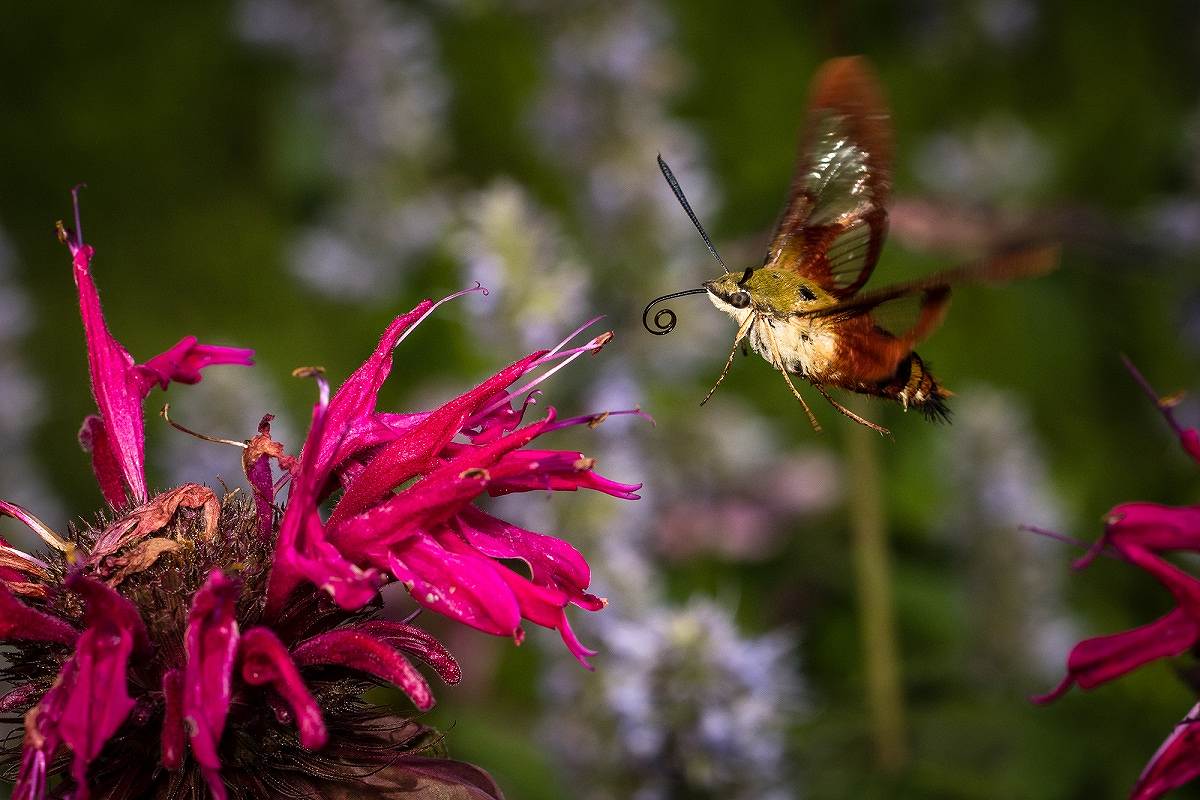
The hummingbird clearwing is a distinctive daytime moth imitating the flight and coloration of hummingbirds.
12:31 JST, August 18, 2023
Think of a monarch butterfly flying near flowers in your backyard on a summer day. Now think of a moth circling a lamp. Which caught your attention? If you said the butterfly, you’re probably not alone. But you’re missing out.
As a lepidopterist, I am here to tell you that moths are woefully underappreciated, despite their importance to the environment. Their sheer numbers only begin to speak to their relevance: One in 10 described species of organisms on Earth is a moth, and a recent study from the University of Sussex in Britain showed that moths are more efficient pollinators than bees. They serve as main dietary sources for bats (when moths aren’t jamming their sonar) and birds (96% of songbirds rely on them for food). Moths also contribute directly to our lives; they produce silk that we use for our clothing, for example. Did you know that the worm in a bottle of tequila is also a moth caterpillar?
With more than 160,000 species, these enigmatic creatures far outnumber the 19,500 species we call butterflies, and they can be as diminutive as a pinhead or as large as an adult’s palm. (In fact, butterflies are now classified by scientists as day-flying moths.) Moths are found in terrestrial plant communities from subpolar regions to the equator. Their kaleidoscope of colors and patterns range from dazzling to cryptic, epitomizing the art of camouflage.
Why, then, are some pollinators celebrities but not the ubiquitous moth? One reason is likely because we don’t see them as frequently; they are active in darkness. But nature doesn’t just happen during the day.
And so, unfortunately, moths have remained out of the spotlight (so to speak) as one of the vital animal groups vanishing quickly. It is estimated that 90% of moth species have caterpillars that feed on only one kind of plant. Because of their strict diet, they are at great risk, relying on their plants to survive. Human-induced environmental change is an overarching cause, and the potential consequences are serious. The disappearance of moths is predicted to have a significant cascading effect that will lead to major losses of plants and animals that rely on them.
Thankfully, efforts are underway to save moths. Conservation groups are now focusing on moths as well as butterflies to protect them and their habitats. Want to help? The first step is noticing them. Then, start taking pictures and sharing them. That way we’ll get a census. Apps such as iNaturalist allow scientists to understand what is happening to moth ranges and populations, and you might even break some new ground by discovering a species that is not from your area or even a new species to science.
But either way, I promise, if you stop what you’re doing and look at a moth, you’ll find wonder and beauty that’s been waiting there all along.
Akito Kawahara is director and curator of Lepidoptera at the Florida Museum of Natural History. Carla Rhodes is a conservation photographer based in Woodstock, N.Y.
"News Services" POPULAR ARTICLE
-

American Playwright Jeremy O. Harris Arrested in Japan on Alleged Drug Smuggling
-

Japan’s Nikkei Stock Average as JGB Yields, Yen Rise on Rate-Hike Bets
-

Japan’s Nikkei Stock Average Licks Wounds after Selloff Sparked by BOJ Hike Bets (UPDATE 1)
-

Japanese Bond Yields Zoom, Stocks Slide as Rate Hike Looms
-

Japan’s Nikkei Stock Average Buoyed by Stable Yen; SoftBank’s Slide Caps Gains (UPDATE 1)
JN ACCESS RANKING
-

Keidanren Chairman Yoshinobu Tsutsui Visits Kashiwazaki-Kariwa Nuclear Power Plant; Inspects New Emergency Safety System
-

Imports of Rare Earths from China Facing Delays, May Be Caused by Deterioration of Japan-China Relations
-

University of Tokyo Professor Discusses Japanese Economic Security in Interview Ahead of Forum
-

Japan Pulls out of Vietnam Nuclear Project, Complicating Hanoi’s Power Plans
-

Govt Aims to Expand NISA Program Lineup, Abolish Age Restriction





















